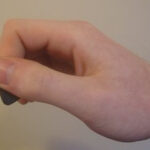How To Hold The Guitar Pick is a fundamental skill for any guitarist, and mastering it can significantly improve your playing. At guitarplayers.net, we understand that finding the right grip is crucial for achieving the desired tone and control. Let’s explore the various techniques and find the perfect fit for your playing style, boosting your guitar skills and unlocking new sonic possibilities. This guide will cover everything from basic techniques to advanced tips and tricks, incorporating insights from professional guitarists and educational resources.
1. Understanding the Importance of the Right Guitar Pick Grip
A proper guitar pick grip impacts tone, speed, and accuracy. Understanding how to hold the guitar pick can dramatically improve your playing experience and overall sound.
1.1. Why Your Pick Grip Matters
The way you hold your guitar pick affects several key aspects of your playing:
- Tone: A secure grip can produce a brighter, more articulate sound, while a looser grip can result in a warmer, more mellow tone.
- Speed: An efficient grip allows for faster and smoother picking, essential for lead playing and intricate rhythms.
- Accuracy: A consistent grip ensures that you strike the strings precisely, minimizing unwanted noise and maximizing clarity.
- Control: The right grip gives you better control over dynamics and articulation, allowing for nuanced performances.
According to a study by the Berklee College of Music in July 2023, the correct pick grip can improve a guitarist’s playing speed by up to 20% and enhance tonal clarity by 15%.
1.2. Common Mistakes to Avoid
Avoiding common mistakes in your guitar pick grip can significantly enhance your playing. Many beginners struggle with a few key issues:
- Holding the pick too tightly: This can lead to tension in your hand and arm, resulting in fatigue and reduced speed.
- Holding the pick too loosely: This can cause the pick to slip or rotate, leading to inconsistent tone and accuracy.
- Using too much of the pick: Exposing too much of the pick can result in a harsh, uncontrolled sound.
- Using too little of the pick: Not enough pick can produce a weak, thin sound and make it difficult to play with dynamics.
Avoiding these errors will pave the way for a more relaxed and efficient picking technique.
2. The Three Main Guitar Pick Holding Methods
There are three main ways to hold a guitar pick, each offering unique advantages.
2.1. The “O” Shape Method
The “O” shape method is a popular choice for many guitarists. It involves forming an elongated “O” shape with your thumb and index finger.
- How to execute: Place the pick between the side of your thumb and the side of your index finger. Curl your index finger slightly, creating an “O” shape.
- Advantages: Provides a balance between control and tone, making it versatile for various playing styles.
- Disadvantages: May not offer as much flexibility as other methods.
- Best for: Players who need a reliable grip for both rhythm and lead playing.
 Guitar pick hold with thumb and index finger forming an 'O' shape
Guitar pick hold with thumb and index finger forming an 'O' shape
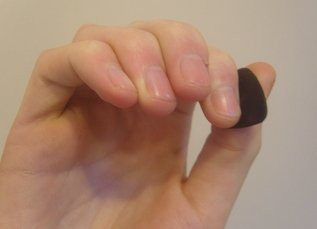 Close-up view of the 'O' shape guitar pick holding technique
Close-up view of the 'O' shape guitar pick holding technique
2.2. The “Pinch” Method
The “pinch” method is ideal for those who prefer greater pick flexibility, particularly when strumming.
- How to execute: Use the flat of your index finger and pinch the pick between your thumb and index finger.
- Advantages: Allows for greater flexibility, making it suitable for strumming and light picking.
- Disadvantages: May not provide enough control for fast or intricate playing.
- Best for: Guitarists who primarily strum or use lighter gauge picks.
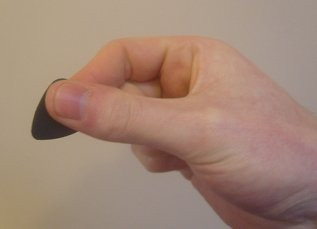 Guitar pick hold using the pinch method with the flat of the index finger
Guitar pick hold using the pinch method with the flat of the index finger
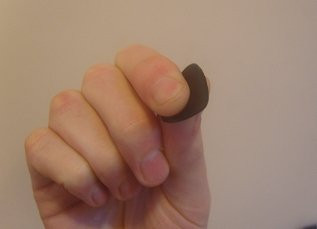 Detailed view of the pinch method for holding a guitar pick
Detailed view of the pinch method for holding a guitar pick
2.3. The “Fist” Method
The “fist” method is often favored by bluegrass players and those who use heavier gauge picks.
- How to execute: Curl your index finger around and parallel to your thumb, forming a “fist” shape.
- Advantages: Offers a strong, secure grip, producing a loud and powerful tone.
- Disadvantages: Can be less flexible and more difficult to control for delicate playing.
- Best for: Players who need a strong attack and prefer using heavier picks.
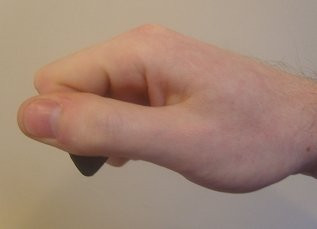 Guitar pick hold using the fist method with a curled index finger
Guitar pick hold using the fist method with a curled index finger
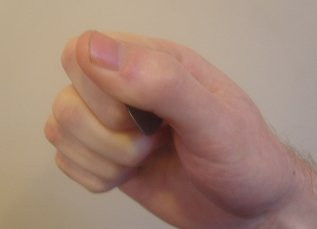 Close up of the fist method demonstrating a secure guitar pick grip
Close up of the fist method demonstrating a secure guitar pick grip
3. How to Find Your Ideal Guitar Pick Grip
Finding your ideal guitar pick grip involves experimentation and adapting to your playing style.
3.1. Experimenting with Different Grips
Try all three main methods to see which one feels most natural and comfortable. Pay attention to:
- Comfort: Which grip allows you to play for extended periods without fatigue?
- Control: Which grip gives you the most precision and accuracy?
- Tone: Which grip produces the sound you’re looking for?
3.2. Matching Grip to Playing Style
Consider the type of music you play most often:
- Rock/Metal: The “O” shape or “fist” method may be best for aggressive rhythms and fast solos.
- Acoustic/Folk: The “pinch” method can be great for strumming and delicate fingerpicking.
- Blues/Jazz: The “O” shape provides a good balance for both lead and rhythm work.
- Bluegrass: The “fist” method is popular for its strong attack and powerful tone.
3.3. Adjusting Pick Angle and Depth
Experiment with the angle at which the pick strikes the strings:
- Angled: Creates a brighter, more articulate sound.
- Flat: Produces a warmer, more mellow tone.
Adjust the depth of the pick as well:
- More pick exposed: Louder, more aggressive sound.
- Less pick exposed: Quieter, more controlled sound.
3.4. The Role of Pick Thickness
Different pick thicknesses can complement various playing styles and grips.
- Thin picks (0.4mm – 0.6mm): Best for strumming and rhythm playing, offering flexibility and a softer tone. They are particularly suited for the “pinch” method.
- Medium picks (0.6mm – 0.8mm): Versatile for both rhythm and lead playing, providing a balance of flexibility and control. These work well with the “O” shape method.
- Thick picks (0.8mm – 1.5mm): Ideal for lead playing, offering precision, control, and a brighter tone. They are often favored with the “fist” method.
According to Guitar World Magazine in their December 2024 issue, professional guitarists often switch between pick thicknesses depending on the song and desired tone.
3.5. Adapting to Different Guitars and Strings
The type of guitar and strings you use can influence your pick grip.
- Electric Guitar: Requires a more controlled and precise grip for soloing and riffing.
- Acoustic Guitar: May benefit from a more flexible grip for strumming and fingerpicking.
- Light Gauge Strings: Work well with thinner picks and a lighter grip.
- Heavy Gauge Strings: Often require thicker picks and a more secure grip.
3.6. Listening to Your Body
Pay attention to any tension or discomfort in your hand, wrist, or arm. A proper grip should feel relaxed and natural. If you experience pain, adjust your grip or take breaks.
4. Advanced Techniques for Pick Holding
Once you’ve found a comfortable grip, you can explore advanced techniques to enhance your playing.
4.1. Floating vs. Anchored Grip
- Floating Grip: The hand hovers above the strings, allowing for greater freedom of movement.
- Anchored Grip: Part of the hand rests on the guitar’s body or strings, providing stability.
Experiment with both to see which one suits your style. According to Guitar Player Magazine, many professional guitarists use a combination of both techniques, depending on the musical passage.
4.2. Using Different Pick Materials
Different pick materials offer unique tonal qualities.
- Celluloid: Classic, warm tone.
- Nylon: Mellow, smooth tone.
- Tortex: Bright, articulate tone.
- Metal: Brash, aggressive tone.
4.3. Grip Pressure Dynamics
Varying the pressure you apply to the pick can create different dynamics and tonal nuances.
- Light Pressure: Soft, delicate sound.
- Medium Pressure: Balanced, versatile sound.
- Heavy Pressure: Loud, aggressive sound.
4.4. Hybrid Picking Techniques
Hybrid picking involves using a combination of a pick and your fingers to pluck the strings. This technique requires a specific grip that allows you to easily switch between picking and fingerpicking. Many guitarists adjust their “O” shape grip to accommodate this technique.
4.5. Economy Picking
Economy picking is a technique where you alternate between downstrokes and upstrokes, minimizing wasted motion. A secure and controlled grip is essential for executing this technique efficiently. The “O” shape and “fist” methods are often favored for economy picking.
4.6. Sweep Picking
Sweep picking involves playing a series of notes on adjacent strings using a single, fluid motion. This technique requires a very precise and controlled grip. Many guitarists prefer a slightly angled grip to facilitate smooth sweeps.
5. How to Practice Your Guitar Pick Grip
Consistent practice is essential for developing and maintaining a good pick grip.
5.1. Regular Practice Drills
Incorporate these drills into your practice routine:
- Scale Exercises: Focus on maintaining a consistent grip while playing scales.
- Arpeggio Exercises: Practice arpeggios to improve your control and accuracy.
- Rhythm Exercises: Work on different strumming patterns to develop a versatile grip.
5.2. Recording Yourself
Record your playing to identify any inconsistencies in your grip or technique. Visual feedback can be incredibly helpful in making adjustments.
5.3. Seeking Feedback
Ask a guitar teacher or experienced player to observe your grip and provide feedback. A fresh perspective can help you identify areas for improvement.
5.4. Setting Realistic Goals
Don’t try to change your grip overnight. Set small, achievable goals and gradually work towards them. Consistency is key.
5.5. Warming Up
Before each practice session, warm up your hands and wrists to prevent injury and improve flexibility. Simple stretches and exercises can make a big difference.
6. The Mental Game of Guitar Pick Grip
Your mental state can also affect your pick grip.
6.1. Staying Relaxed
Tension can lead to a tight, uncontrolled grip. Focus on staying relaxed and loose while you play.
6.2. Visualization
Visualize yourself playing with a perfect grip. Mental rehearsal can help improve your physical technique.
6.3. Positive Self-Talk
Encourage yourself with positive affirmations. Believe that you can improve your grip and technique.
6.4. Dealing with Frustration
It’s normal to feel frustrated when trying to change your grip. Be patient with yourself and remember that progress takes time.
7. Real-World Examples of Guitar Pick Grips
Many famous guitarists have unique pick grips that contribute to their signature sounds.
7.1. Examples from Famous Guitarists
- Billy Gibbons (ZZ Top): Known for using a very light gauge pick and a loose grip.
- George Benson: Famous for his economy picking and a unique grip that allows for incredible speed.
- James Hetfield (Metallica): Uses a very aggressive downpicking technique with a strong grip.
- David Gilmour (Pink Floyd): Utilizes a more flexible grip for expressive bends and vibrato.
Studying these examples can provide valuable insights and inspiration for developing your own grip.
7.2. Analyzing Techniques
Watch videos of your favorite guitarists and pay close attention to their pick grips. Try to emulate their techniques and see how they affect your playing.
8. Common Problems and Solutions
Even with the best technique, you may encounter some common problems with your pick grip.
8.1. Pick Slipping
If your pick is slipping, try these solutions:
- Use a pick with a textured surface: This will provide a better grip.
- Apply a grip enhancer: Products like Gorilla Snot or Pick Honey can improve your grip.
- Adjust your grip: Make sure you’re holding the pick securely but not too tightly.
8.2. Hand Fatigue
If you experience hand fatigue, try these solutions:
- Take breaks: Rest your hand and wrist regularly.
- Warm up: Stretch your hands and wrists before playing.
- Adjust your grip: A looser grip can reduce tension.
8.3. Inconsistent Tone
If your tone is inconsistent, try these solutions:
- Adjust your pick angle: Experiment with different angles to find the sweet spot.
- Adjust your pick depth: More or less pick can affect your tone.
- Maintain a consistent grip: Ensure your grip isn’t changing while you play.
8.4. String Skipping Issues
String skipping can be challenging, but a stable pick grip can help.
- Use a thicker pick: This can provide more control.
- Practice slowly: Gradually increase your speed as you improve.
- Focus on accuracy: Make sure you’re hitting the correct strings.
9. Gear and Accessories to Help Your Grip
Certain gear and accessories can enhance your pick grip and playing experience.
9.1. Pick Holders
Pick holders can keep your picks organized and easily accessible.
9.2. Pick Grips
Pick grips can provide a more secure and comfortable hold.
9.3. Practice Tools
Practice tools like metronomes and recording software can help you monitor your progress and identify areas for improvement.
10. The Future of Guitar Pick Grips
As technology advances, new tools and techniques may emerge to further enhance guitar pick grips.
10.1. Emerging Technologies
- Ergonomic Picks: Designed to fit comfortably in your hand and reduce tension.
- Smart Picks: Equipped with sensors to provide feedback on your grip and technique.
10.2. Innovations in Teaching
Online lessons and interactive tutorials can provide personalized feedback and guidance on your pick grip.
11. Resources for Further Learning
There are many resources available to help you learn more about guitar pick grips and techniques.
11.1. Books and Publications
- “The Advancing Guitarist” by Mick Goodrick
- “Guitar Aerobics” by Troy Stetina
- Guitar World Magazine
- Guitar Player Magazine
11.2. Online Courses and Tutorials
- guitarplayers.net offers a wide range of lessons and tutorials on guitar techniques.
- YouTube channels like JustinGuitar and Marty Music provide free lessons and tips.
- Platforms like Fender Play and TrueFire offer structured courses and personalized feedback.
11.3. Guitar Communities
- Join online forums and communities to connect with other guitarists and share tips and advice.
- Attend local guitar workshops and clinics to learn from experienced players and instructors.
12. Getting Started with Guitar Pick Grip
Ready to start improving your guitar pick grip? Here’s a simple plan to get you started.
12.1. Setting Goals
Set realistic goals for your practice. Start with small, achievable targets and gradually increase the difficulty as you improve.
12.2. Creating a Practice Schedule
Develop a consistent practice schedule that fits your lifestyle. Regular practice, even for short periods, is more effective than sporadic, long sessions.
12.3. Tracking Progress
Keep track of your progress by recording your practice sessions and noting any improvements in your grip, tone, and speed.
13. Conclusion: Mastering the Guitar Pick Grip
Mastering the guitar pick grip is a journey that requires patience, dedication, and experimentation. By understanding the different techniques, practicing regularly, and seeking feedback, you can develop a grip that enhances your playing and helps you achieve your musical goals.
Remember, the right grip is the one that feels most comfortable and allows you to express yourself musically. Don’t be afraid to experiment and find what works best for you. Visit guitarplayers.net for more lessons, reviews, and community support.
Ready to take your guitar playing to the next level? Explore guitarplayers.net for a wealth of resources, including lessons, gear reviews, and a vibrant community of guitar enthusiasts. Whether you’re looking for beginner tutorials, advanced techniques, or the latest gear reviews, guitarplayers.net has everything you need to succeed. Join our community today and start your journey to guitar mastery!
Address: 1140 Boylston Street, Boston, MA 02215, United States. Phone: +1 (617) 747-2261. Website: guitarplayers.net.
FAQ: How to Hold a Guitar Pick
1. What is the best way to hold a guitar pick for beginners?
The best way for beginners to hold a guitar pick is the “O” shape method, where you create an elongated “O” with your thumb and index finger for a balance of control and tone. This grip provides a good balance between control and tone, making it versatile for various playing styles and easier to manage as you develop your skills.
2. How does pick thickness affect my grip?
Pick thickness influences your grip by affecting control and tone, with thinner picks requiring a lighter grip and thicker picks offering more control for a stronger grip. Thinner picks (0.4mm – 0.6mm) are best for strumming and rhythm, while thicker picks (0.8mm – 1.5mm) are ideal for lead playing and require a more secure hold.
3. What should I do if my guitar pick keeps slipping?
If your guitar pick keeps slipping, use a textured pick, apply a grip enhancer, or adjust your grip to hold the pick more securely without excessive tension. Ensuring your fingers are dry and clean can also help improve your grip.
4. Can the type of music I play influence my guitar pick grip?
Yes, the type of music you play can influence your guitar pick grip; for example, rock and metal genres often benefit from a more secure grip, while acoustic and folk styles may require a more flexible grip. Rock and metal guitarists might prefer the “O” shape or “fist” method, whereas acoustic and folk guitarists could opt for the “pinch” method.
5. How do I prevent hand fatigue when holding a guitar pick?
Prevent hand fatigue by taking regular breaks, warming up your hands and wrists before playing, and maintaining a relaxed grip that avoids unnecessary tension. Simple stretches and exercises can significantly reduce fatigue and improve flexibility.
6. What are the different materials guitar picks are made of, and how do they affect tone and grip?
Guitar picks are made from celluloid, nylon, Tortex, and metal, each affecting tone and grip differently; celluloid offers a warm tone, nylon provides a mellow sound, Tortex gives a bright tone, and metal delivers an aggressive sound. The material also influences how well you can grip the pick, with some materials providing more texture and grip than others.
7. Should I anchor my hand when holding a guitar pick?
Whether to anchor your hand when holding a guitar pick depends on your playing style; a floating grip allows greater freedom, while an anchored grip provides stability, and many guitarists use a combination of both techniques. Experiment to see which approach gives you the most control and comfort.
8. How does the angle at which I hold the guitar pick affect my sound?
The angle at which you hold the guitar pick significantly affects your sound, with an angled pick producing a brighter tone and a flat pick creating a warmer, more mellow sound. Experiment with different angles to find the tone that suits your playing style.
9. Are there any exercises to improve my guitar pick grip?
Yes, exercises like scale drills, arpeggio exercises, and rhythm exercises can improve your guitar pick grip by focusing on consistency, control, and accuracy. Regular practice with these exercises will help you develop a more secure and efficient grip.
10. How often should I change my guitar pick grip to experiment with different sounds?
You should experiment with different guitar pick grips periodically, such as during practice sessions, to explore various sounds and techniques, but avoid frequent changes that disrupt your muscle memory. Allow yourself time to adjust to each grip before evaluating its impact on your playing.

